
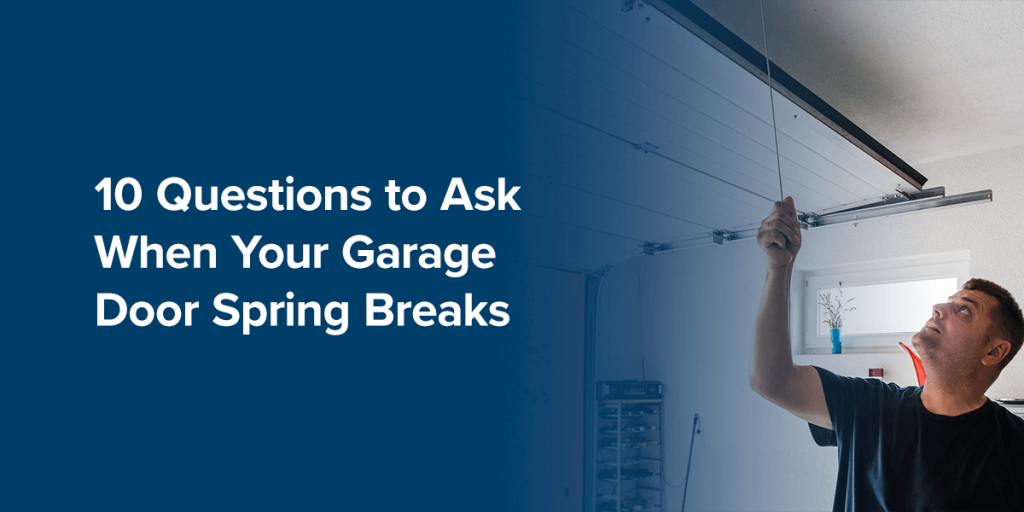
A smoothly functioning garage door is crucial to the overall upkeep of your house. It’s something you use every day. You might park your car in the garage, or you might keep power tools, a lawnmower or bicycles in it. To get all of these items in and out of the garage safely and efficiently, you need access to a properly functioning garage door.
If the garage door is broken or damaged, it can affect the feeling of the entire house. It’s an inconvenience, and it can also make your entire house feel less sophisticated and less functional. If you happen to be trying to sell your house, this can seem like a major detraction. Even if you’re only having guests over, you may feel as though you’re doing less than putting your best foot forward by having a broken garage door.
Call 336-813-2601 Now For Repair Services
There are lots of ways your garage door can suffer damage. The tracking might be rusted or broken, the weatherstripping might need to be replaced or the door itself might actually be broken or have a hole in it. After all, garage doors are sturdy but not unbreakable. One component of your garage door in particular that will likely need replacing every so often is the spring.
This small component is crucial to your door’s operation since it does all the heavy lifting of bringing up and putting down your garage door. Your garage door needs springs to function, so if the spring breaks, your door will not operate. Even if you’re not having problems with your garage door spring, it’s a good idea to get it replaced every so often to ensure the continued well-being and smooth operation of your garage door.
Jump to Section:
A garage door spring is a tiny but critical part of your door’s opening mechanism. It takes the torque of the garage door and makes it easier to lift and open. Without this spring, the door would be much harder — sometimes even impossible — to lift. Garage doors can’t work well without it.

Even though most of us are likely used to seeing this small spring in place on our garage door, we don’t often think too much about it — until it stops working. We simply count on it working when we need it to. Unfortunately, it doesn’t last forever and will eventually need to be replaced. It’s best to be proactive and notice when it begins to look worn down before it actually breaks. Otherwise, you may find yourself trying to open the garage door to drive to work one morning, only to find that the door won’t open because the spring is broken.
So your garage door is acting up, but you aren’t sure what the problem is. Maybe the door spring is one possible culprit, but you’re not sure if that’s actually the problem or if it’s something else. In this quick list, we’ll go through the most common ways to tell if your garage door spring is broken. If your garage door is exhibiting one or a few of the following symptoms, there’s a good chance the spring is broken and needs replacing:
Request Spring Replacement Services
This is one of the first things most homeowners notice about a broken spring — the door cables will become disconnected and fly every which way if the spring is no longer working. The cables themselves are fine. They just need a working spring to be able to function properly. Does your garage door seem to open just fine for a few inches, but then it stops and refuses to go any farther? This is a safety feature of many garage doors. It prevents the door from being opened when the springs are broken.
Homeowners might hear a loud sound in their garage and think someone is trying to break in. But they look in the garage and find no one there. In reality, the sound was most likely made by the door spring unwinding and creating a crashing sound in the door mechanism.
Knowing what a broken garage spring looks like is important to determining what’s wrong with your garage. Look for a gap of a few inches in the middle of your torsion spring.
Some types of garage doors will bend at the top if you try to open them with a broken spring. This is due to the immense weight the mechanism is now trying to lift without the aid of the spring.
As we mentioned, the garage door is a huge amount of weight. With the broken spring unable to carry the load, it’s difficult for the mechanism to let the door down gently. Instead, it will just drop the door in place with a very sudden and jarring motion.
Your garage door should have a red emergency rope hanging from the opening mechanism. If you pull on this and the door fails to open, your spring is most likely broken.

If this happens, you might have only one spring broken in a two-spring system. This means the mechanism is still strong enough to lift the door but not strong enough to do it smoothly.
If the spring on one side of the garage door is broken, this might cause the door to become crooked as it moves up and down on its track.
When the spring breaks, the entire system is thrown out of sync. The pulleys and cables might become loose and be left hanging down from the ceiling.
As you can tell, even though you might not always see a broken spring, the symptoms of it are clear and distinct as long as you know what to look for. But why do garage door springs break in the first place? Is a broken spring a rare occasion, caused only by a specific incident, or is it a common occurrence that happens gradually over time?
As you might guess, it can be both. Let’s go over a few common causes of broken garage door springs now.
Garage door springs are made of metal, meaning they’re susceptible to rust. If any rust develops in the spring, its lifespan can be cut short by years. Rust weakens the coiled spring and also increases the amount of friction, causing it to wear faster.
Fortunately, there’s an easy fix to this problem. Spray the spring with some WD-40 a few times every year to prevent rust from gaining a foothold on the spring.
Garage door springs don’t require extensive care and maintenance. However, they also can’t be left entirely to their own devices. Spraying the springs with WD-40 is a good place to start. It’s also a good idea to check the balance of the garage door every year. To do this, simply lift the garage door up about halfway and let go. If the springs are in good working condition, the door should remain still. If the springs are beginning to weaken, the door might sag or fall. By taking these basic steps, you can preserve your door springs for longer.
Garage Door Preventive Maintenance Services
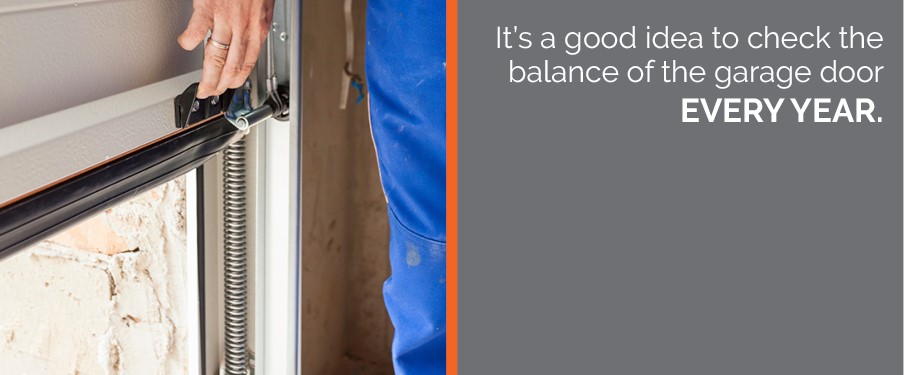
Everyone wants to save money. Unfortunately, there are some areas you just can’t skimp on. This includes garage door springs. As much as it might be tempting to buy smaller or cheaper springs, or maybe to buy one spring where two are needed, these attempts to save money will only end up costing more money in the end.
When you buy the proper springs, they’ll last for years. When you cut corners to save money, the springs will wear out faster, meaning they’ll need to be replaced much sooner.
While it would be wonderful if door springs lasted forever, the reality is that the simple act of opening and shutting the door multiple times every day isn’t easy. It’s hard on the springs, even though they’re built to do it. Most springs will last for a while, but they won’t last forever. The regular wear and tear of endlessly opening and shutting the door breaks them down, and eventually, they’ll need to be replaced.
One way to counteract this is making an effort to use your garage door less often. For instance, if a friend is dropping you off or your car doesn’t fit in the garage, use a house key to get into your home instead of opening and closing the garage door.
Although garage door springs can break during any season and at any time, they most commonly break during the winter. This has to do with the temperature change. When the temperature sinks below a specific threshold, the metal will contract. This means it’s extremely possible for your door springs to shrink slightly during the winter months. Shrinking is hard on the springs and makes them more likely to break.
A garage door might also break more frequently in the wintertime if the outdoor temperature drops very quickly. And if your springs are already worn out, the chances of them breaking in the winter becomes higher.
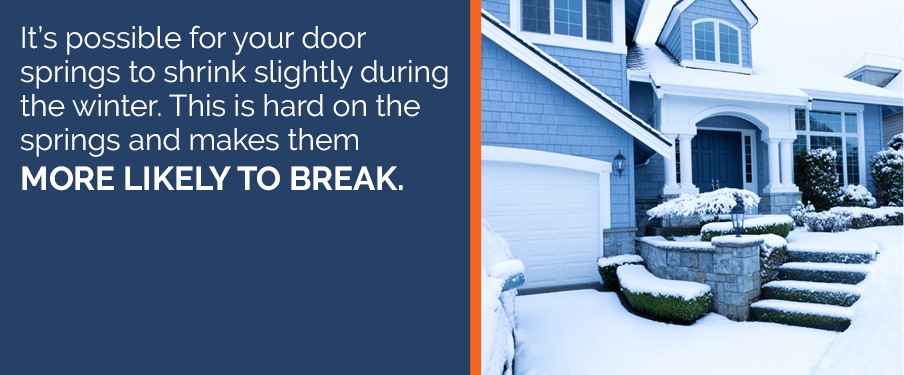
While it isn’t possible to prevent your garage door springs from breaking in the wintertime, it is possible to lessen the problem by applying plenty of oil to the springs.
The simplest answer to how often to replace your garage door springs is as often as they need it. Even if your door continues to open and shut with a broken spring, it’s highly inadvisable to continue operating the door this way. It’s best to just replace the springs and save yourself potential headaches later on.
It’s difficult to say how often garage door springs break because it’s different for everyone. It depends on how often you use your garage door, how cold and long your winters are, how well you maintain your springs and many other factors.
For instance, if you’re using your garage door every day, multiple times a day, the springs will wear faster than if you only use it a few times every week. The best rule of thumb is to check your springs regularly for signs of wear and damage and to replace them when they begin to appear tired. You can even have a garage door professional inspect your door yearly to catch any issues that you might miss yourself and perform “tune-ups.”
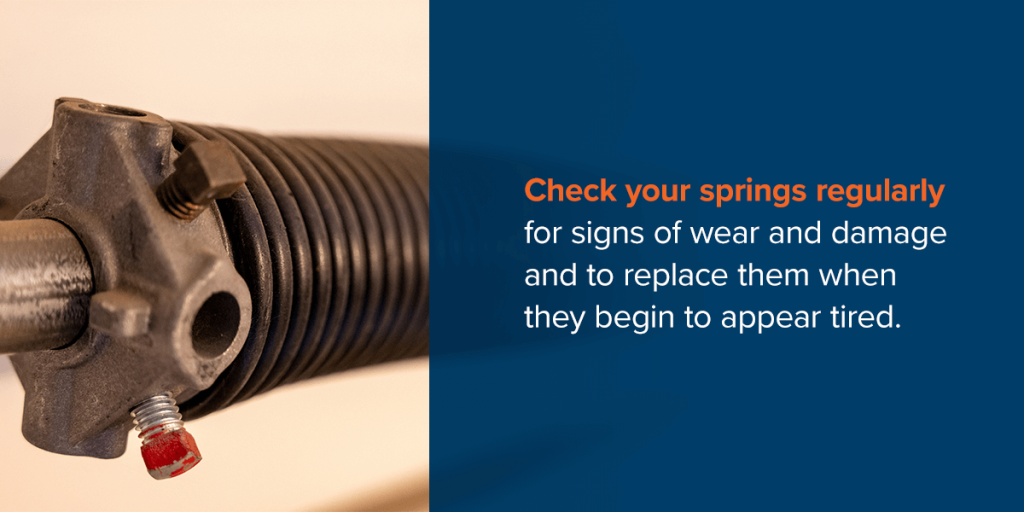
There are two primary types of garage door springs — extension and torsion. Both are reliable, excellent designs, but they’re designed for different types of garages. By understanding what type of garage you have and what type of spring is best suited to this type of garage, you can ensure the best success with your new spring.
A few general characteristics of the extensions spring are:
A few general characteristics of the torsion spring are:
When you decide it’s time to replace your garage door spring, you will almost certainly replace it with one of these two options. If you’re uncertain of which type is right for your garage, first consider what kind of garage you have.
If you have a single-car garage, an extension spring is the better choice. If you’re looking for a smoother motion and an ability to lift heavier doors, you may be better off selecting the torsion spring option. And if you have a two-car garage, your door will likely be too heavy for an extension spring. In this case, the torsion spring is the better choice.
What is the cost to replace a garage door spring? This is likely one of the first questions you’ll ask yourself after you realize you need to replace your door spring. The answer is that it depends. Extension springs and torsion springs are priced differently, so the cost to replace a garage door spring depends on which type of spring you’re interested in buying.
Extension springs tend to be less expensive. This makes them a great option if you only have a single car garage and you’re operating on a tight budget. A typical garage door extension spring can cost anywhere between $25 and $45. Replacing them costs between $95 and $150. Extension springs usually last 7-12 years, or between 8,000 to 15,000 cycles. Even if only one of your springs breaks, it’s recommended to replace both of them at the same time, both to maintain balance and because if one goes, the other is likely to follow.
Torsion springs will cost slightly more than extension springs. And while this greater price tag may look intimidating at first, it will pay off as you enjoy the smooth action and impressive strength of this model for years to come, as their life expectancy is about 8-15 years — roughly 10,000-20,000 cycles!
A good torsion spring will typically cost somewhere between $105 and $350, and replacing garage door torsion springs can cost between $95 and $150. Due to the additional weight and increased size, double door springs might cost $15 to $30 more per spring. Maybe you’re looking to convert your existing extension springs to torsion, which costs anywhere from $400 to $800.
As we mentioned earlier, it can be a good idea to have a professional perform a “tune-up” on your garage yearly. Annual tune-ups can save you a lot of money in the long run, and they generally cost between $50 and $150.
No matter how tight your budget is, these garage door spring prices are worth it. The risks associated with continuing to use your garage door when the spring is faulty are numerous. These risks range from life-threatening danger if the door fails when someone is standing under it to being annoying when you can’t get the car out of the garage and you’re supposed to be somewhere in 10 minutes.
While getting replacement garage door springs is inevitable, there are certain steps you can take that will extend your springs’ life expectancy. We’ve already mentioned a few of these techniques, but we’ll list them all here for your convenience.
Your garage door springs should be cleaned at least twice every year. While you can certainly clean them more than this if you want, you shouldn’t clean them any less than this. This doesn’t have to be an extensive process. A simple cleaning and lubricating are all it takes to keep your springs working well and slow the eventual wear and tear.
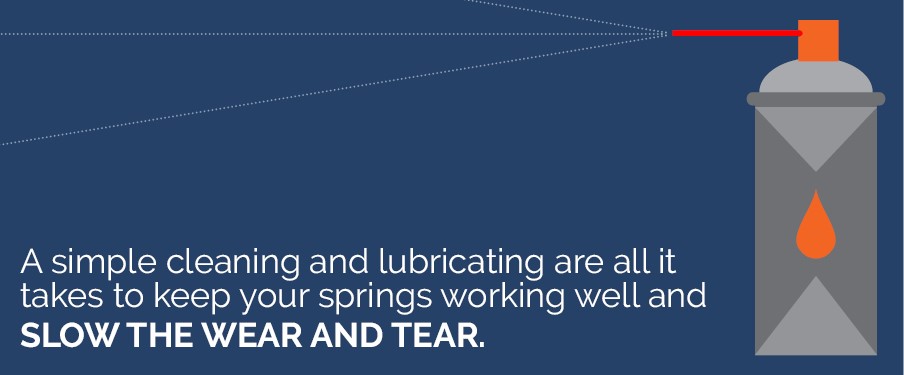
To clean your garage door springs, look for significant buildup of dirt or debris to dust away using a soft-bristle brush. A bit of dust is fine to leave, as the springs are durable enough to withstand that. To lubricate your garage springs, coat them with a silicone spray or white lithium grease, but be careful not to let any drip onto your car or onto the garage floor.
We’ve discussed the way rust can shorten a spring’s lifespan. A rusty spring will have months and even years shaved off its life simply because of the way the rust eats away at the metal. It’s easy enough to stave off the rust, however, by giving your springs a quick spray with WD-40.
One of the best ways to care for your springs is to check them over for wear. You can certainly look at them for damage, but sometimes the damage isn’t something that’s visible. In these cases, try lifting the garage door up from the ground. About halfway up, let go. If the door stays, the springs are still working perfectly. If the door sags or drops at all, this could be a sign that your springs are beginning to weaken and will need replacing soon.
This is a very important question. When it comes to replacing parts in machines or around the house, many people want to try to do it themselves. They like the idea of saving money, and they like the industrious feeling of accomplishing things with their own two hands.
However, we strongly recommend against doing this. Replacing garage door springs is a dangerous and difficult job. It’s not the kind of job where you can read a few instructions, gather a few tools and knock it out in an hour. It takes trained professionals to do this job correctly.
Replacing garage springs is a job for professionals because it’s:
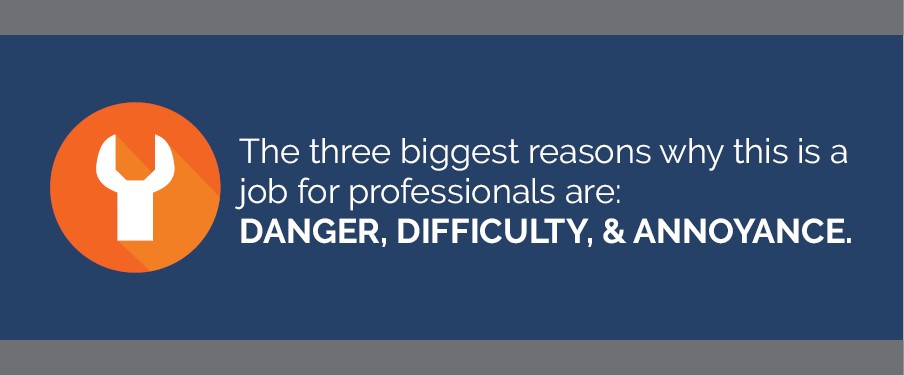
There’s never a convenient time for your garage door springs to break. When this crucial component gives out, you need a repair job or replacement as soon as possible. That’s why Marvin’s Garage Doors is available 24/7 for emergency service. When an emergency arises, or you’re stuck in your garage and are unable to get out to get to work, give us a call on our emergency line at 336-813-2601.
At Marvin’s Garage Doors, we have years of experience in fixing and replacing broken garage door springs. We know how to get the job done in a timely, efficient and safe manner so you can get back to your regular routine with as little headache as possible.
Our services aren’t just limited to garage door springs, either. We offer a full range of services including garage door purchase, installation and repairs. Contact us online anytime to request a particular service or check out our showrooms in Wilkesboro, Winston-Salem, East Bend and Lake Norman.
